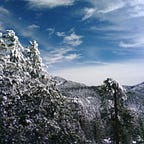San Francisco in VHS
Recently I went to San Francisco, and I took a camcorder with me. But not an HD camcorder, which I used when I went to “Baghdad by the Bay” more than a decade ago, but a thirty-year old VHS camcorder. I thought it would be fun.
I went for three days, so I took three cassettes, one per day, each having 30-minute capacity. After I had returned, I digitized the tapes, selected three to five minutes of footage from each and put them on YouTube.
It rained on the first day of my stay. I boarded a trolleybus and went to Alta Plaza park, which is located on the top of a hill. On a good day I would see for many miles away, but it was rainy and foggy, and I could barely see the blinking light on the three-legged Sutro Tower.
On a second day I went to the Marina, watched the construction of a safety net under the Golden Gate bridge, which will be located 20 feet below and extending 20 feet away from the bridge. With its completion, jumping beyond the net will become a challenge in its own. Then I went to the Pier.
On the third day I visited the Lands End on the North-West side of the city. The Cliff House overlooks the strait and the remains of Sutro baths, which burned down to its concrete foundations in 1966.
The Cliff House, which was home to several restaurants, closed its doors to the public on December 31, 2020 and sits all but abandoned. There is a note on a window saying that there are plans to convert it into a museum.
During my trip, I wanted to use some of the filters I bought a while ago. In particular, I felt that graduated filters would be useful when shooting in a format that has very narrow dynamic range.
Graduated blue filter works better on a bright, sunny day, making the sky very vivid.
On a cloudy day, graduated blue gives an appearance of a rain cloud.
Graduated gray or neutral density filter produces natural if somewhat gloomy look on a cloudy day.
Diffraction filter would probably work at a party. It did not add much pizzazz to an evening street.
I had several options to digitize the tapes. The camcorder I used to shoot the video records SVHS video and Hi-Fi audio, but it does not have a time base corrector (TBC). I have another camcorder, a newer one, which also records and plays SVHS, and it has built-in TBC that eliminates jitter and ensures straight frame edges, but it does not play Hi-Fi audio and has only monophonic audio output.
So, to capture the best possible video and audio, I used a full-size VHS machine: it can record and play SVHS video, it can record and play Hi-Fi audio, and it has built-in TBC with full-frame memory. To play a compact VHS cassette I used an adapter, which converts a small cassette into a full-sized one.
On this shoot I played with built-in fades. Most of them are plain-looking and boring, but there are several useful ones, like fade in/out black, fade in/out white, mosaic and crossfade.
The first three are rather simple: when you stop a shot, the camcorder records another second or so, fading the image out. When you start the next shot, it fades the first second in. Mosaic works the same way, so you can see where one shot ends and another begins.
Crossfade is different: when you stop a shot, the camcorder back up a second or so. Then when you start the next shot, it juggles the erase head power and recording head power to make a dissolve. It looks seamless thanks to flying erase heads.
San Franciscans love their public transportation. Besides well-known BART and cable car they have buses, trolleybuses, classic street cars and high-speed streetcars that double as subway in downtown.
Lately, they have been buying EVs at the highest rate in the country, every third new registered vehicle is an EV.
EVs are used as a platform for autonomous ride-hailing services like Cruise, which offers truly driverless service, and Waymo, which has not received all the needed permissions yet, so its Jaguar I-Pace vehicles are being driven by humans. With all the radars, lidars and rotating cameras it looks every bit as a police car from a 1980s sci-fi movie.
Using a VHS camcorder for three days strengthened my appreciation of modern digital video technology. And it is not just a matter of analog standard definition versus digital highdef. There are other things like better imager sensitivity, reliable autofocus, automatic and manual exposure modes, image stabilization, more audio options, smaller and lighter battery packs and, finally, the workflow.
With a tape-based camcorder everything is linear and real-time. Analog video has to be digitized for editing on a computer, and depending on digitizing method the quality will vary. Moreover, thirty years ago you would be editing with two tape decks, not on a computer.
With file-based workflow we use nowadays you copy clips as files, usually much faster than realtime. No worrying about chewed tape or clogged video heads. Good times! ■
